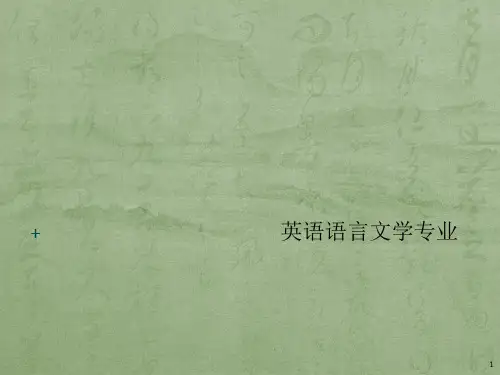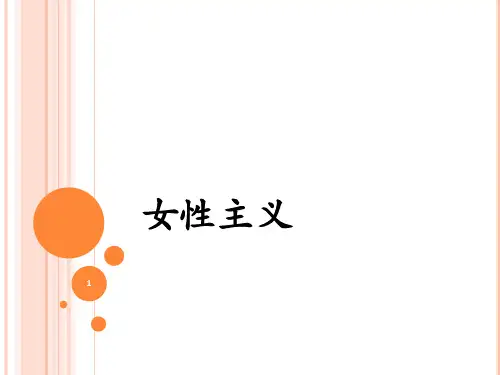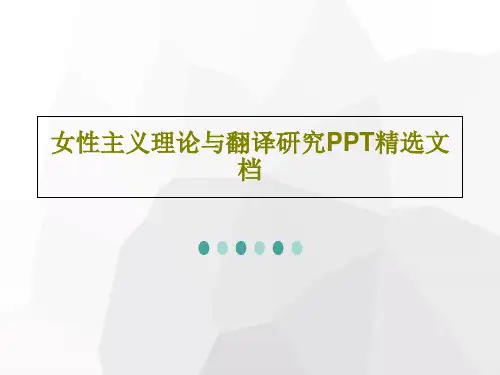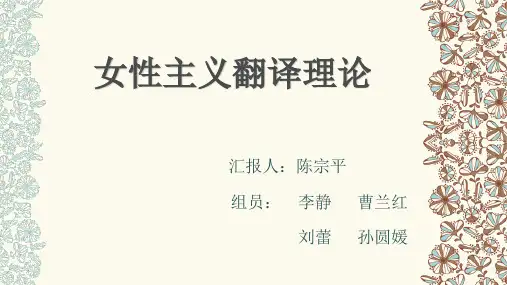当代国外翻译理论导读 第六章女性主义翻译理论56页PPT
- 格式:ppt
- 大小:6.98 MB
- 文档页数:56

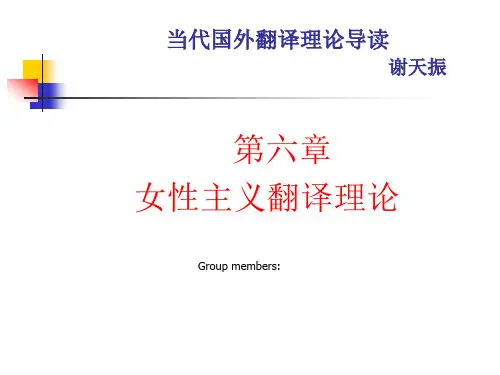
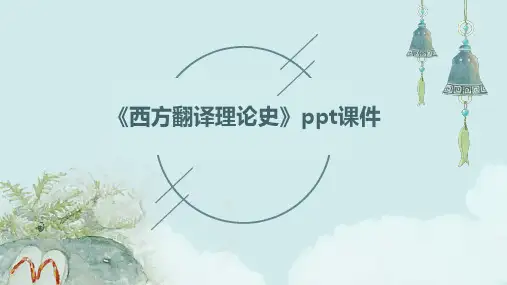
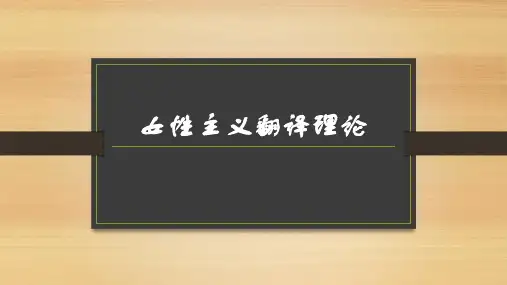
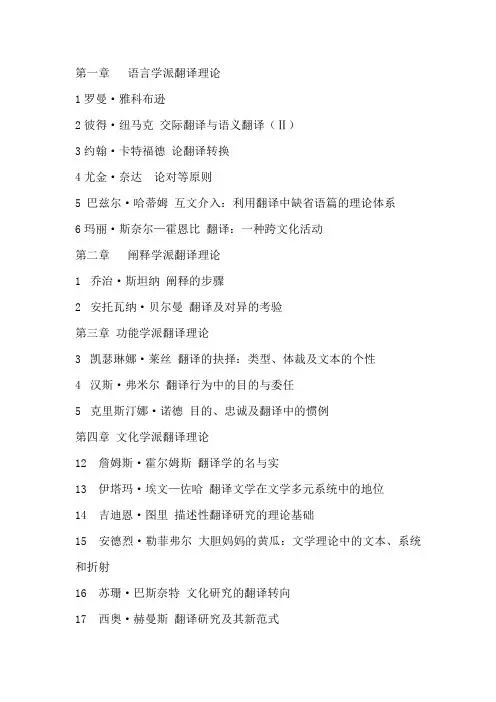
1罗曼·雅科布逊2彼得·纽马克交际翻译与语义翻译(Ⅱ)3约翰·卡特福德论翻译转换4尤金·奈达论对等原则5 巴兹尔·哈蒂姆互文介入:利用翻译中缺省语篇的理论体系6玛丽·斯奈尔—霍恩比翻译:一种跨文化活动第二章阐释学派翻译理论1乔治·斯坦纳阐释的步骤2安托瓦纳·贝尔曼翻译及对异的考验第三章功能学派翻译理论3凯瑟琳娜·莱丝翻译的抉择:类型、体裁及文本的个性4汉斯·弗米尔翻译行为中的目的与委任5克里斯汀娜·诺德目的、忠诚及翻译中的惯例第四章文化学派翻译理论12 詹姆斯·霍尔姆斯翻译学的名与实13 伊塔玛·埃文—佐哈翻译文学在文学多元系统中的地位14 吉迪恩·图里描述性翻译研究的理论基础15 安德烈·勒菲弗尔大胆妈妈的黄瓜:文学理论中的文本、系统和折射16 苏珊·巴斯奈特文化研究的翻译转向17 西奥·赫曼斯翻译研究及其新范式18 瓦尔特·本雅明译者的任务19 雅克·德里达巴别塔之旅20.保罗·德曼评本雅明的《译者的任务》21.劳伦斯·韦努蒂文化身份的塑造第六章女性主义翻译理论22.雪莉·西蒙翻译理论中的性别化立场23.劳丽·钱伯伦性别与翻译的隐喻24.巴巴拉·格达德女性主义话语/翻译的理论化25.冯·弗罗托女性主义翻译理论批评第七章后殖民翻译理论26.道格拉斯·罗宾逊后殖民研究与翻译研究27.特佳斯维妮·尼南贾纳翻译的定位28.盖亚特里·斯皮瓦克翻译的政治29.埃尔斯·维埃拉解放卡利班们——论食人说与哈罗德·德·坎波斯的超越/越界性创造诗学第八章苏东学派翻译理论30.安德烈·费奥多罗夫翻译理论的任务31.吉维·加切奇拉泽文学翻译中的创造性原则32.吉里·列维翻译是一个作选择的过程33.安娜·丽洛娃翻译研究的范畴6Roman Jakobson论翻译的语言学问题“On Linguistic Aspectsof Translation”布拉格语言学派创始人罗曼·雅科布逊1959年发表的《论翻译的语言学问题》首先将语言学、符号学引进了翻译学,他把语言分为“语内翻译(Intralingual Translation)、语际翻译(Interlingual Translation) 和符际翻译(Intersemiotic Translation)”(三分法理论)。

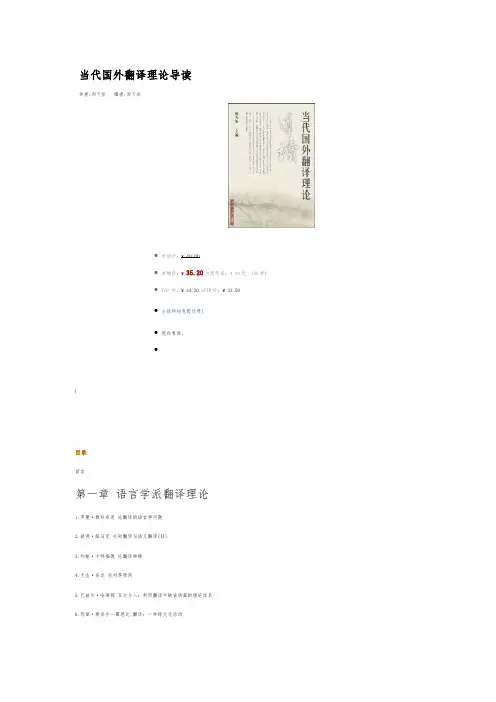
当代国外翻译理论导读作者:谢天振编者:谢天振•市场价:¥40.00•卓越价:¥35.20为您节省:4.80元(88折)•VIP 价:¥34.20 SVIP价:¥33.50•全场购物免配送费!•现在有货。
•)目录前言第一章语言学派翻译理论1.罗曼·雅科布逊论翻译的语言学问题2.彼得·纽马克交际翻译与语义翻译(Ⅱ)3.约翰·卡特福德论翻译转换4.尤金·奈达论对等原则5.巴兹尔·哈蒂姆互文介入:利用翻译中缺省语篇的理论体系6.玛丽·斯奈尔—霍恩比翻译:一种跨文化活动第二章阐释学派翻译理论7.乔治·斯坦纳阐释的步骤8.安托瓦纳·贝尔曼翻译及对异的考验第三章功能学派翻译理论9.凯瑟琳娜·莱斯翻译的抉择:类型、体裁及文本的个性10.汉斯·弗米尔翻译行为中的目的与委任11.克里斯汀娜·诺德目的、忠诚及翻译中的惯例第四章文化学派翻译理论12.詹姆斯·霍尔姆斯翻译学的名与实13.伊塔玛·埃文—佐哈翻译文学在文学多元系统中的地位14.吉迪恩·图里描述性翻译研究的理论基础15.安德烈·勒菲弗尔大胆妈妈的黄瓜:文学理论中的文本、系统和折射16.苏珊·巴斯奈特文化研究的翻译转向17.西奥·赫曼斯翻译研究及其新范式第五章解构学派翻译理论18.瓦尔特·本雅明译者的任务19.雅克·德里达巴别塔之旅20.保罗·德曼评本雅明的《译者的任务》21.劳伦斯·韦努蒂文化身份的塑造第六章女性主义翻译理论22.雪莉·西蒙翻译理论中的性别化立场23.劳丽·钱伯伦性别与翻译的隐喻24.巴巴拉·格达德女性主义话语/翻译的理论化25.冯·弗罗托女性主义翻译理论批评第七章后殖民翻译理论26.道格拉斯·罗宾逊后殖民研究与翻译研究27.特佳斯维妮·尼南贾纳翻译的定位28.盖亚特里·斯皮瓦克翻译的政治29.埃尔斯·维埃拉解放卡利班们——论食人说与哈罗德·德·坎波斯的超越/越界性创造诗学第八章苏东学派翻译理论30.安德烈·费奥多罗夫翻译理论的任务31.吉维·加切奇拉泽文学翻译中的创造性原则32.吉里·列维翻译是一个作选择的过程33.安娜·丽洛娃翻译研究的范畴Translation Theory(2007-09-29 14:13:41)标签:学习公社translationenglishtheoryTranslation TheoryBy Juan Daniel Pérez VallejoTranslation teacher,University of Cd. Del Carmen, Campeche, MexicoThe study of proper principle of translation is termed as translation theory. This theory, based on a solid foundation on understanding of how languages work, translation theory recognizes that different languages encode meaning in differing forms, yet guides translators to find appropriate ways of preserving meaning, while using the most appropriate forms of each language. Translation theory includes principles for translating figurative language, dealing with lexical mismatches, rhetorical questions, inclusion of cohesion markers, and many other topics crucial to good translation. Basically there are two competing theories of translation. In one,the predominant purpose is to express as exactly as possible the full force and meaning of everyword and turn of phrase in the original, and in the other the predominant purpose is to produce a result that does not read like a translation at all, but rather moves in its new dress with the same ease as in its native rendering. In the hands of a good translator neither of these two approaches can ever be entirely ignored. Conventionally, it is suggested that in order to perform their job successfully, translators should meet three important requirements; they should be familiar with: the source languagethe target languagethe subject matterBased on this premise, the translator discovers the meaning behind the forms in the source language and does his best to produce the same meaning in the target language - using the forms and structures of the target language. Consequently, what is supposed to change is the form and the code and what should remain unchanged is the meaning and the message. (Larson, 1984)One of the earliest attempts to establish a set of major rules or principles to be referred to in literary translation was made by French translator and humanist Étienne Dolet, who in 1540 f ormulated the following fundamental principles of translation ("La Manière de Bien Traduire d’une Langue en Aultre"), usually regarded as providing rules of thumb for the practicing translator:The translator should understand perfectly the content and intention of the author whom he is translating. The principal way to reach it is reading all the sentences or the text completely so that you can give the idea that you want to say in the target language because the most important characteristic of this technique is translating the message as clearly and natural as possible. If the translation is for different countries besides Mexico, the translator should use the cultural words of that country. For example if he/she has to translate ”She is unloyal with her husband” in this country it can be translated as “Ella le pone los cuernos” but in Peru it can be translated as “Ella le pone los cachos”. In this case it is really important the cultural words because if the translator does not use them correctly the translation will be misunderstood.The translator should have a perfect knowledge of the language from which he is translating and an equally excellent knowledge of the language into which he is translating. At this point the translator must have a wide knowledge in both languages for getting the equivalence in the target language, because the deficiency of the knowledge of both languages will result in a translation without logic and sense. For example if you translate the following sentence “Are you interested in sports?” as “¿Estás interesado en deportes?” the translation is wrong since the idea of this question in English is “¿Practicas algún deporte?”The translator should avoid the tendency to translate word by word, because doing so is to destroy the meaning of the original and to ruin the beauty of the expression_r. This point is very important and one of which if it is translated literally it can transmit another meaning or understanding in the translation.For example in the sentence.- “In this war we have to do or die”, if we translate literally “En esta guerra tenemos que hacer o morir” the message is unclear. The idea is, (.) “En esta guerra tenemos que vencer o morir.”The translator should employ the forms of speech in common usage. The translator should bear in mind the people to whom the translation will be addressed and use words that can be easily understood.Example. “They use a sling to lift the pipes” if the translation is to be read by specialists we would translate it “Utilizan una esling a para levantar la tubería”. If the text is to be read by people who are not specialists we would rather translate it “Utilizan una cadena de suspension para levantar los tubos”.Flip to Text Version La Trobe UniversityHarry AvelingA Short History of Western Translation Theory1. Traditional Translation TheoriesThere is a continuity of intellectual expression from Ancient Greece, Rome, the Middle Ages, through to the Renaissance, the Reformation, and the rise of the early European nation states. The central language of scholars and other readers was Latin, while the core of this tradition was classicalliterature and Judeo-Christianity. There was a profusion of economic and political contacts throughout Europe and the Middle East, and this must have involved an abundance of linguistic transactions. Nevertheless, Lefevere"s words provide an accurate background to understanding the social position of the subjects of traditional translation theory: "In such a culture, translations were not primarily read for information or the mediation of the foreign text. They were produced and read as exercises, first pedagogical exercises, and later on, as exercises in cultural appropriation - in the conscious and controlled usurpation of authority." (Lefevere 1990: 16).2. German RomanticismAt the beginning of the nineteenth century, a second, more philosophical and less empirical, formation began to open within discourses on translation theory (Munday 2001: 27). This formation was connected, in one direction, with the rise of philology as a university discipline, and in another with the literary movement of Romanticism. Philology provided a range of new and exotic texts and allowed the experts to produce translations aimed primarily at other experts, not the general culture of which these scholars were a part (Lefevere 1990: 22). Romanticism exalted the translator "as a creative genius in his own right, in touch with the genius of his original and enriching the literature and language into which he is translating" (Bassnett-McGuire 1980: 65). The stress on both the original author and the translator as being artists was not part of traditional discourse formations.3. The Early and Middle Twentieth CenturyDiscussion in English of translation theory during the first half of the twentieth century continued to be dominated by the themes of Victorian discourse on translation, "literalness, archaizing, pedantry and the production of a text of second-rate literary merit for an elite minority" (Bassnett-McGuire 1980: 73). In his list of major contributors to the area of translation theory, Steiner recognises only the names of Dryden, Quine and Pound among English-speakers. Quine and Pound both belong to the twentieth century and challenged the dominant discourse. Willard V. Quine (b. 1908), a major American philosopher, wrote on "the indeterminacy of translation" within the field of linguistic philosophy (Quine 1960). Ezra Pound (1885-1972) was a poet and critic. Ronnie Apter has argued that Pound made three major innovations to thinking about "the nature and intent of literary translation…he discarded the Victorian pseudo-archaic translation diction; he regarded each translation as a necessarily limited criticism of the original poem; and he regarded good translations as new poems in their own right" (Apter 1987: 3).More radical, and more decisive, developments in translation theory took place in Europe. These begin with the Russian Formalist movement, whichfocused on the "what makes literary texts different from other texts, what makes them new, creative, innovative" (Gentzler 1993: 79). One of their answers was that literary texts rely on a process of "defamiliarisation", using language in new and strikingly different ways from ordinary speech. This led the Formalist to focus on "surface structural features" and "to analyse them to learn what determines literary status" (Gentzler 1993: 79). In so doing, they began the search for descriptive rules, which would help scholars understand the process of translation, and not normative rules, in order to study and assess the work of other translators (Bell 1991: 12). Their work was extended and refined by the Prague school of linguistics, founded by Roman Jakobson, who had earlier worked in Moscow. In his essay "On the Linguistic Aspects of Translation" (1959), Jakobson expanded traditional discourse of "equivalence" into the theme of "equivalence in difference". In so doing, he argued that words should be seen within their (arbitrary) semiotic context, and that "the grammatical pattern of a language (as opposed to its lexical stock) determines those aspects of each experience that must be expressed in the given language" (Venuti 2000: 114).4. Translation StudiesThree factors worked to limit this sharp focus on descriptive linguistics as the major form of discourse on translation. The first was the questioning of Chomsky"s linguistic theories by linguists themselves. The second was the development of a number of new and dynamic fields within linguistics, such as "discourse analysis, text linguistics, sociolinguistics, computational linguistics, prototype semantics, and other assorted wonders" (Pym 1992: 184). These "wonders" took in prior fields such as British social anthropology and American cultural anthropology, as well as contemporary and parallel developments in philosophy, information and communication theories, computational linguistics, machine translation, artificial intelligence, and the ideas of socio-semiotics as developed within French structuralist and post-structuralist thought (Nida 2001: 110). The sense increased that: "Language is not the problem. Ideology and politics are…" (Lefevere 1990: 26). This has led to a separation between linguistic and cultural approaches to translation in the last quarter of the twentieth century. For some translation scholars, indeed, it has seemed that "strictly linguistic theories have been superseded, [as] translation has come to be considered in its cultural, historical and sociological context" (Woodsworth 1998: 100).Basic Knowledge of Translation TheoryI.Translation1.Definition1)The definition in the old daysl“译即易,谓换易言语使相解也。
